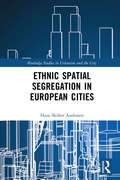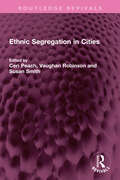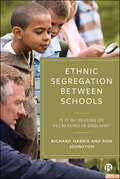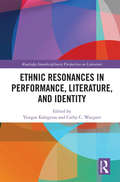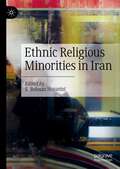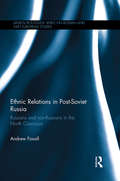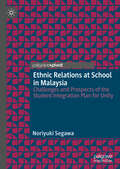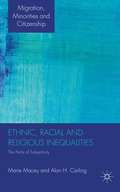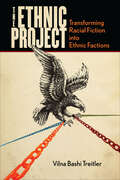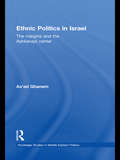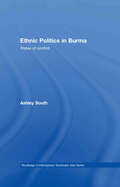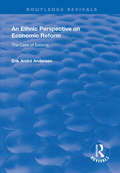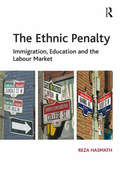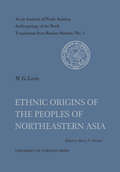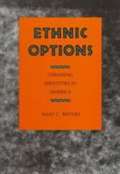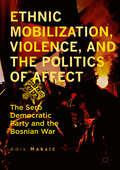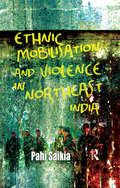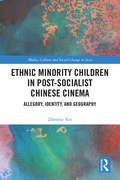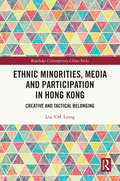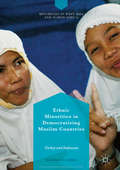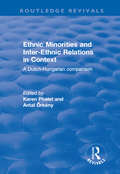- Table View
- List View
Ethnic Spatial Segregation in European Cities (Routledge Studies in Urbanism and the City)
by Hans Skifter AndersenThis book provides the first in depth interpretation of how to understand the causes of ethnic residential segregation across Western European countries and the USA. In many countries, ethnic minorities have obtained low quality housing and may be concentrated in certain parts of cities. This book asks to what extent ethnic segregation can be assigned to special preferences for housing and neighbourhoods among ethnic minorities. Is it the behaviour of the native majority, or is it a result of housing and urban policies? Ethnic segregation differs greatly across European countries and cities. Chapters discuss the extent to which these differences can be explained by welfare state systems, levels of immigration and the ethnic composition of minorities. The book also considers the impact of housing policy and the spatial structure of urban housing markets created by urban planning and policies. This book will appeal to teachers, students and researchers working with segregation, urban sociology and geography. It will also be valuable to civil servants in central and local governments who are working with measures to combat ethnic segregation and its consequences.
Ethnic Segregation in Cities (Routledge Revivals)
by Ceri Peach Vaughan Robinson Susan SmithFirst published in 1981, Ethnic Segregation in Cities argues that race and ethnicity are fundamental to writing about the city, and that economic patterns adapt themselves to race and ethnicity rather than vice versa. The problem of ethnic segregation is a burning one for both geographers and sociologists – geographers because of the concern for all aspects of urban deprivation, and sociologists because they are discovering that space and spatial processes are important factors in influencing social segregation or assimilation. The book brings together some of the main contributors to the literature on spatial aspects of ethnicity from both sides of the Atlantic. A variety of evidence from New York, Detroit, Bradford and Blackburn address the question of whether choice on the path of ethnic members, or constraints imposed by the host society are determinant factors influencing residential segregation. This book will be of interest to students of sociology, human geography and urban studies.
Ethnic Segregation Between Schools: Is It Increasing or Decreasing in England?
by Richard Harris Ron JohnstonThere is an enduring belief amongst some that segregation is worsening and undermining social cohesion, and that this is especially visible in the growing divides between the schools in which our children are educated. This book uses up-to-date evidence to interrogate some of the controversial claims made by the 2016 Casey Review, providing an analysis of contemporary patterns of ethnic, residential and social segregation, and looking at the ways that these changing geographies interact with each other.
Ethnic Resonances in Performance, Literature, and Identity (Routledge Interdisciplinary Perspectives on Literature)
by Yiorgos Kalogeras Cathy C. WaegnerThis volume seeks to weave applications of the dynamic concept of resonance to ethnic studies. Resonance refers to the ever broadening, multidirectional effects of movement or action, a concept significant for many disciplines. The individual chapters exchange the concept of static "intertextuality" for that of interactive "resonance," which encourages consideration of the mutual and processual influences among readings, paradigms, and social engagement in cultural analysis. International scholars of literary and cultural studies, linguistics, history, politics, or ethno-environmental studies contribute their work in this volume. Each chapter examines a specific ethnic phenomenon in terms of relevant literature, lived experience and theoretical approaches, or historical intervention, relating the given case study to parameters of resonance. The book offers dialogic transnational interchange, a play of eclectic ethnic voices, inquiries, perspectives, and differences. The studies in this interdisciplinary volume show that – through resonant engagement with(in) and between works – literary production can both enhance and disturb cultural narratives of ethnicity.
Ethnic Religious Minorities in Iran
by S. Behnaz HosseiniThis book explores the experiences of the ethnic and religious minorities of Iran, such as Jews, Yarsani, Christian, Sabean Mandaean, Bahai, Zoroastrian, Baluch, Kurd, and others and provides a historical overview of their position in society before and after the 1979 Islamic revolution and highlights their contribution to the country's history, diversity, and development. It also focuses on the historical, sociopolitical, and economic factors that affected the minorities' development during the last century. Author Behnaz Hosseini has shaped this book with authentic material and has assembled the experiences and opinions of academics of diverse backgrounds who approach the minorities’ issues in Iran in a constructive and ingenious way: from debating their efforts to preserve their identity and cultural heritage and ensure their survival to discussing their relations with the majority and other minorities, the role of religion in everyday life, and their contribution to the rich cultural history of Iran.
Ethnic Relations in Post-Soviet Russia: Russians and Non-Russians in the North Caucasus (BASEES/Routledge Series on Russian and East European Studies)
by Andrew FoxallWhile the collapse of communism in Russia was relatively peaceful, ethnic relations have been deteriorating since then. This deterioration poses a threat to the functioning of the Russian state and is a major obstacle to its future development. Analysing ethnic relations in the North Caucasus, this book demonstrates how a myriad of processes that characterised post-Soviet transition, including demographic change, economic upheaval, geopolitical instability, and political re-structuring, have affected daily life for citizens. It raises important questions about ethnicity, identity, nationalism, sovereignty, and territoriality in the post-Soviet space.
Ethnic Relations at School in Malaysia: Challenges and Prospects of the Student Integration Plan for Unity
by Noriyuki SegawaThis book considers the impact of the Rancangan Integrasi Murid Untuk Parpaduan (RIMUP: Student Integration Plan for Unity), the program developed as a driver towards Malaysian national integration and intended to promote an ideal of ‘unity in diversity’ through enhancing ethnic interaction in primary schools. Based on interview research with government departments, NGOs, and stakeholders at primary schools, this book highlights three main structural challenges to success of the RIMUP: the government’s weak management; the short duration and low frequency of an activity; and low student participation rate. The book also provides concrete suggestions to develop the RIMUP, to improve ethnic relations and to shape the future direction of education policies for the development of national integration, making a significant contribution to Malaysian studies as well as education policy in multi-ethnic countries.
Ethnic, Racial and Religious Inequalities
by Marie Macey Alan CarlingThis book challenges some of the most basic assumptions underpinning the growing interest in religion, including: that religion is increasing and secularisation is decreasing and that religion is the main component of identity for all minority ethnic people.
The Ethnic Project: Transforming Racial Fiction into Ethnic Factions (Stanford Studies In Comparative Race And Ser.)
by Vilna Bashi TreitlerRace is a known fiction--there is no genetic marker that indicates someones race--yet the social stigma of race endures. In the United States, ethnicity is often positioned as a counterweight to race, and we celebrate our various hyphenated-American identities. But Vilna Bashi Treitler argues that we do so at a high cost: ethnic thinking simply perpetuates an underlying racism. In "The Ethnic Project," Bashi Treitler considers the ethnic history of the United States from the arrival of the English in North America through to the present day. Tracing the histories of immigrant and indigenous groups--Irish, Chinese, Italians, Jews, Native Americans, Mexicans, Afro-Caribbeans, and African Americans--she shows how each negotiates Americas racial hierarchy, aiming to distance themselves from the bottom and align with the groups already at the top. But in pursuing these "ethnic projects" these groups implicitly accept and perpetuate a racial hierarchy, shoring up rather than dismantling race and racism. Ultimately, "The Ethnic Project" shows how dangerous ethnic thinking can be in a society that has not let go of racial thinking.
Ethnic Politics in Israel: The Margins and the Ashkenazi Centre (Routledge Studies in Middle Eastern Politics)
by As'ad GhanemThis book offers an analysis on contemporary Israeli democracy, examining in particular society and politics from the perspectives of the different ethnic groups outside of the Ashkenazi mainstream. The book explores the political expressions of the secondary groups in Israel (Mizrahim, Religious, Russians and Palestinian-Arab) and how these groups where treated by the Ashkinazim as a threat to its hegemony over the state. Looking at the instability created by the struggle of these marginal groups against the state, and the discrimination policy practiced by the Ashkenazi 'hegemonic ethnic state' regime against the other, non-Ashkenazi, groups, the book illustrates how this has contributed to the failure to establish an ‘Israeli people’. Ethnic Politics in Israel will be of great interest to students and researchers in the fields of Middle East, Palestinian, Arab, Jewish and Israeli studies, political science, sociology and psychology.
Ethnic Politics in Burma: States of Conflict (Routledge Contemporary Southeast Asia Series)
by Ashley SouthThis book examines the ideas which have structured half a century of civil war in Burma, and the roles which political elites and foreign networks - from colonial missionaries to aid worker activists - have played in mediating understandings of ethnic conflict in the country. The book includes a brief overview of precolonial and colonial Burma, and the emergence ethnic identity as a politically salient characteristic. It describes the struggle for independence and the parliamentary era (1948-62), and the quarter century of military-socialist rule that followed (1962-88). The book analyses the causes, dynamics and impacts of on-going armed conflict in Burma, since the 1988 'democracy uprising' through to the 2007 'saffron revolution' (when monks and ordinary people took to the streets in protest against the military regime). There is a special focus on the plight of displaced people, and the ways in which local and international agencies have responded. The book also examines one of the most significant, but least well-understood, political developments in Burma over the last twenty years: the series of ceasefires agreed since 1989 between the military government and most armed ethnic groups. The positive and negative impacts of the ceasefires are analysed, including a study of civil society among ethnic nationality communities. This analysis leads to a discussion of the nature of social and political change in Burma, and a re-examination of some commonly held assumptions regarding the country, including issues of ethnicity and federalism. The book concludes with a brief Epilogue, taking account of Cyclone Nargis, which struck Burma on 2 and 3 May 2008, resulting in a massive humanitarian crisis.
An Ethnic Perspective on Economic Reform: Case of Estonia (Routledge Revivals)
by Erik Andre AndersenFirst published in 1999, this book has its main emphasis on the consequences of privatisation for the Russian population in Estonia, The Book will attempt to answer the following questions by comparing the Estonians and the Russians.The process of restoration of the Republic of Estonia (which began to move fast in the late 1980’s and culminated with the declaration of national independence in 1991) is seen as an important political factor behind the economic reform in Estonia. This reform during the transition period is generally considered to be among the most successful in eastern Europe.
The Ethnic Penalty: Immigration, Education and the Labour Market (Research In Migration And Ethnic Relations Ser.)
by Reza HasmathPopulations of visible ethnic minorities have steadily increased over the past few decades in immigrant-receptive societies. While a complex calculus of push and pull factors has motivated this increase, one of the main impetuses for this migration has been the search for employment, better wages and a higher standard of living. It is therefore not surprising that the educational attainments of the first generation and beyond have achieved convergence with, or exceeded the non-ethnic minority cohort. These outcomes may suggest a greater propensity for visible ethnic minorities to attain labour market success and to fully integrate within the community. However, the narrative derived from statistical analysis, interviews and participant observation suggest an uneasiness boldly to claim this as the most convincing conclusion at this juncture. The Ethnic Penalty argues that a penalty has impeded the occupational success of ethnic minorities during the job search, hiring and promotion process. As a result, ethnic minorities have a lower income, higher unemployment and a general failure to convert their high educational attainments into comparable occupational outcomes. In this context, the book examines whether explanatory factors such as discrimination, an individual's social network, a firm's working culture, and a community's social trust are major contributing reasons behind this apparent penalty, whilst also making suggestions for improving the integration, education delivery, and labour market outcomes of visible ethnic minorities.
Ethnic Origins of the Peoples of Northeastern Asia No. 3
by Henry Michael Maksim LevinThis is a translation from a Russian work published in 1958, one of the major works of a well-known and prolific writer. It deals with the origins of the small nations and peoples of central Siberia and northeastern Asia. Many guesses have been made about these peoples but most have not been substantiated, because of the lack of field work or because the materials on them had not been analysed and published. Levin has reviewed the old materials, gathered and analysed hitherto unpublished ones, and personally surveyed many of the peoples as a member of the Russian Northeastern Expedition. He makes use of all the data of physical anthropology, ethnography, archaeology, and linguistics on the peoples he describes and has thus provided a definitive work on a nearly forgotten segment of mankind inhabiting an extensive territory. Volume III in the series Anthropology of the North: Translations from Russian Sources sponsored by the Arctic Institute of North America and under the general editorship of H.N. Michael, Temple University.
Ethnic Options: Choosing Identities In America
by Mary C. WatersIn this perceptive and revealing study, Mary Waters explores the "reinvention" of ethnicity in the lives of the grandchildren and great grandchildren of European immigrants, asking how their ethnic heritage is lived, maintained, and celebrated. Through in-depth interviews with sixty third and fourth generation white ethnics in suburban California and Pennsylvania, the author discovers a surprisingly resilient sense of ethnicity among people who could reasonably label themselves simply "American. " Mary Waters' research brings to light a fascinating history of American immigration, revealing aspects of a shared culture and ideology and the unique ways in which ethnic identities fulfill very American needs. Describing the "symbolic ethnicity" of later generation white ethnics as a quintessential American phenomenon, she argues that ethnicity has retained its importance in our lives precisely because it allows people to reconcile the contradictory American values of choice, individuality, and community. In addition to her exploration of the symbolic ethnicity of later generation middle-class whites, Mary Waters addresses its cost to society, contrasting it with the optionless ethnicity of non-white Americans. Her conclusions in Ethnic Options constitute an invaluable contribution to our understanding of contemporary American life.
Ethnic Oasis: The Chinese in the Black Hills
by Liping Zhu Rose Estep Foshahe discovery of gold in the Black Hills of South Dakota brought thousands of people to the mining town of Deadwood, including many Chinese immigrants. Ethnic Oasis explores how the Chinese met the challenge of living and working in a land much different from their own. Seeking to surround themselves with the familiar, they established their own "Chinatowns" in Deadwood and other communities throughout the West. From these enclaves, the Chinese competed to succeed in American society. Through diligence and an ability to work within the social and legal systems, many thrived and became respected members of what had been a hostile community. Ethnic Oasis presents the history and archaeology of the Chinese experience in the Black Hills and elsewhere in the West.
The Ethnic Myth: Race, Ethnicity, and Class in America
by Stephen SteinbergSociologist Stephen Steinberg argues that traits which are often considered "ethnic" may well be more directly related to class, locality, and other social conditions. Updated with a lengthy epilogue on recent immigrants and a penetrating reappraisal of the black underclass.
Ethnic Modernism and the Making of US Literary Multiculturalism
by Leif SorensenDuring the 1930s, ethnic literary modernists played a crucial role in the development of what we now recognize as multiethnic literature in the United States. Presenting a new view of the history of multicultural literature, Ethnic Modernism and the Making of US Multiculturalism focuses on the remarkable careers of four ethnic fiction writers: Younghill Kang, D'Arcy McNickle, Zora Neale Hurston, and Américo Paredes. The first part of the book situates these authors within the modernist era to provide an alternative, multicultural vision of American modernism. The second part examines the complex reception histories of these authors' works, showing how they have been claimed or rejected as ancestors for contemporary multiethnic writing. Combining the approaches of modernist studies and ethnic studies, the book presents a new model of twentieth-century American literary history.
Ethnic Mobilization, Violence, and the Politics of Affect: The Serb Democratic Party and the Bosnian War
by Adis MaksićThis book offers an unprecedented account of the Serb Democratic Party’s origins and its political machinations that culminated in Europe’s bloodiest conflict since World War II. Within the first two years of its existence, the nationalist movement led by the infamous genocide convict Radovan Karadzic, radically transformed Bosnian society. It politically homogenized Serbs of Bosnia-Herzegovina, mobilized them for the Bosnian War, and violently carved out a new geopolitical unit, known today as Republika Srpska. Through innovative and in-depth analysis of the Party’s discourse that makes use of the recent literature on affective cognition, the book argues that the movement’s production of existential fears, nationalist pride, and animosities towards non-Serbs were crucial for creating Serbs as a palpable group primed for violence. By exposing this nationalist agency, the book challenges a commonplace image of ethnic conflicts as clashes of long-standing ethnic nations.
Ethnic Mobilisation and Violence in Northeast India
by Pahi SaikiaThe book is a very detailed work on the relationship between movements for autonomy by indigenous peoples (the so-called ‘tribes’) and violence in Assam, in northeast India. The book addresses some of the reasons for the failure of ethnic conflict management and for the frequent emergence of violence in the region. In particular, the historical description of movements by the Dimasas, Misings and Bodos is well compiled and provides a good summary for the readers. At the same time, the work offers a good understanding of ethnic violence in contemporary India.The volume offers some new research data based on comparative analysis of different trajectories followed by three important movements among Assam’s ethnic minorities. While the pieces of the argument are based on the existing literature on ethnic violence and contentious politics, they are effectively connected to materials drawn from northeast India. Furthermore, the book raises significant concerns on the debates on crafting of decentralised institutions and executive opportunities that may facilitate ethnic accommodation thereby reducing the likelihood of such groups to pursue their goals through channels that are radical or extreme.
Ethnic Minority Children in Post-Socialist Chinese Cinema: Allegory, Identity and Geography (Media, Culture and Social Change in Asia)
by Zhenhui YanThis book examines the surprisingly large number of films about ethnic minority children in China, considering key questions such as Why are ethnic minority children becoming more intriguing to Chinese filmmakers? What are their roles in the films literally and allegorically? And how are they placed on screen geographically and why? It argues that ethnic minority children’s appeal lies in their special relationship with childhood, ethnicity, nationalism, and rurality; and that for dominant Han urban adults and elite ethnic minorities they serve as "the other" for these people’s construction of themselves as self-conscious modern subjects during China’s rapid social-political transformations. This book explores the diversity of ways in which both Han and ethnic minority filmmakers take up the special features of ethnic minority children to facilitate their expression of certain ideas or ideals, as well as the roles of these films in their directing careers.
Ethnic Minorities, Media and Participation in Hong Kong: Creative and Tactical Belonging (Routledge Contemporary China Series)
by Lisa Y.M. LeungSecond and third generation South and Southeast Asian minorities in Hong Kong, being marginalized from mainstream social and political affairs, have developed an ambivalent sense of belonging to their host society. Unlike their forefathers who first settled in Hong Kong under British colonial rule, these younger generations have spent their formative years in the territory. As such, they have increasingly engaged in the public and political realms of society, partly in response to the territory’s rapid political changes. Leung discusses and analyses the complex and diverse engagement of migrant and minority youths in Hong Kong - and their struggle for recognition, while desiring to 'be-long' to a place they call home. Some are joining the calls for democratic changes in the territory. In particular, she argues that much of this struggle can be seen in minorities’ involvement in creative sectors of society. While it will be of especial interest to scholars with an interest in Hong Kong, this book presents a compelling case study for anyone interested in the dynamics of migrant and minority engagement in the creative sector as a strategy for engagement.
Ethnic Minorities in Democratizing Muslim Countries: Turkey And Indonesia (Minorities in West Asia and North Africa)
by Maurizio GeriThis book explores the ways in which democratizing Muslim countries treat their ethnic minorities’ requests of inclusiveness and autonomy. The author examines the results of two important cases—the securitization of Kurds in Turkey and the “autonomization” (a new concept coined by the study) of Acehnese in Indonesia—through multiple hypotheses: the elites’ power interest, the international factors, the institutions and history of the state, and the ontological security of the country. By examining states with ethnic diversity and very little religious diversity, the research controls for the effect of religious conflict on minority inclusion, and so allows expanded generalizations and comparisons. In non-Muslim majority countries, and in so called “mature democracies,” the problem of the inclusion of old or new ethnic minorities is also crucial for the sustainability of the “never-ending” democratization processes.
Ethnic Minorities and Politics in Post-Socialist Southeastern Europe
by Sabrina Ramet Marko ValentaSoutheast European politics cannot be understood without taking ethnic minorities into account. This book provides a comprehensive introduction to the politics of ethnic minorities, examining both their political parties and issues of social distance, migration, and ethnic boundaries, as well as issues related to citizenship and integration. Coverage includes detailed analyses of Hungarian minority parties in Romania, Albanian minority parties in Macedonia, Serb minority parties in Croatia, Bosniak minority parties in Serbia, and various minority parties in Montenegro, as well as the Movement for Rights and Freedoms, a largely Turkish party, in Bulgaria.
Ethnic Minorities and Inter-ethnic Relations in Context: A Dutch-Hungarian Comparison (Routledge Revivals)
by KAREN PHALET AND ANTAL ÖRKÉNYThis volume is based on papers presented on ethnic minorities and inter-ethnic relations in Hungary and The Netherlands, which were presented and discussed in three conferences and a series of meetings from 1997-1999. This work builds on comparative studies of the rise of a radical right and the mobilization of anti-immigrant feelings. It presents cross-national comparative research, due to the creedence that shifting national angles is a powerful strategic tool with which to correct national bias and to uncover submerged or overlooked aspects of specific national cases. The book brings together contributions from Hungarian and Dutch scholars in the field of ethnic minorities and inter-ethnic relations. The two countries are used as exemplary cases of distinct ethno-political patterns in Central and Western Europe. Combining complementary configurational and dimensional approaches to cross-national comparison, the diverse forms of ethnic relations in Hungary and The Netherlands are analyzed, and competing explanations of ethno-political conflict (or co-ordination) are tested in both national contexts.
